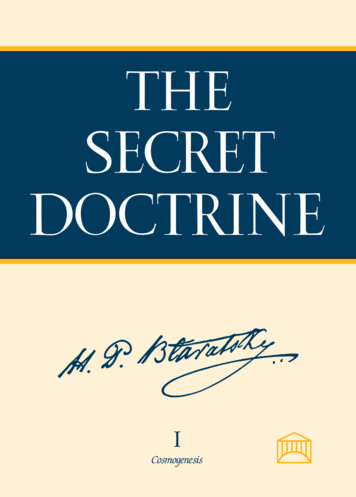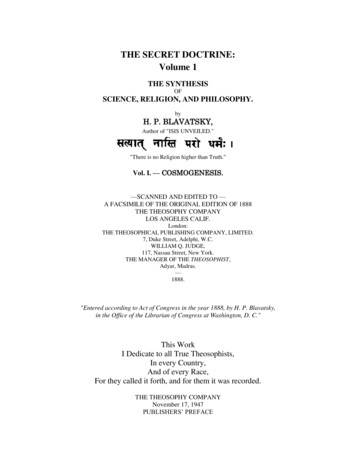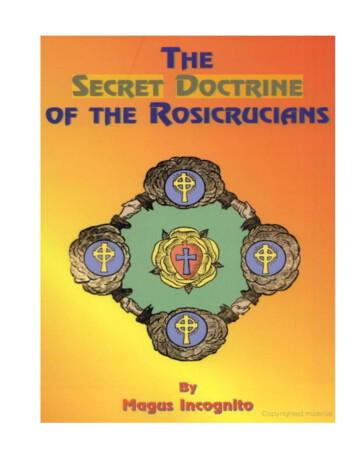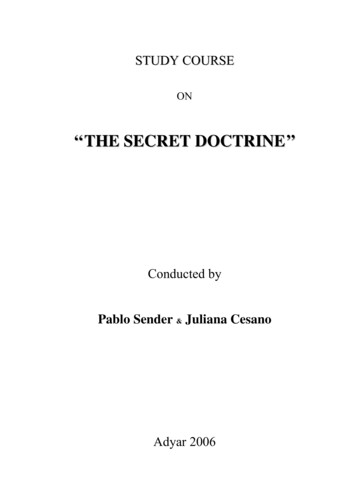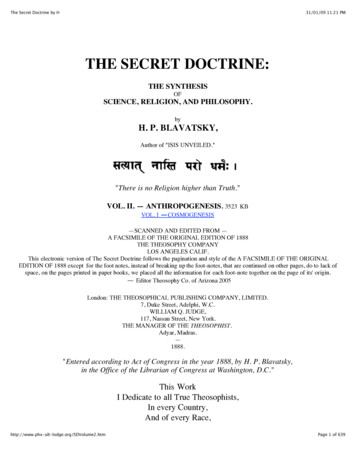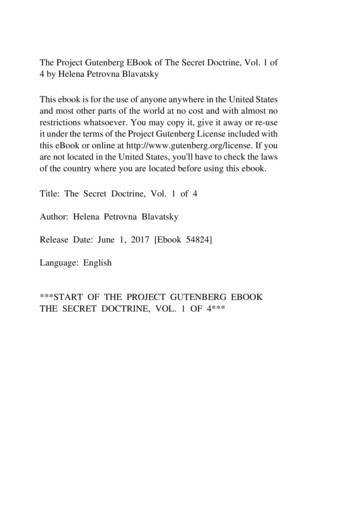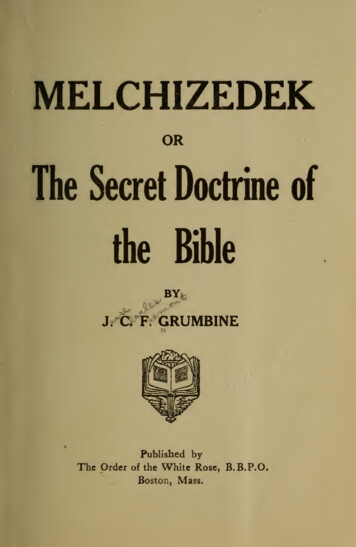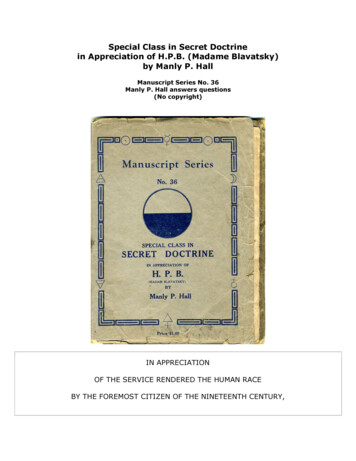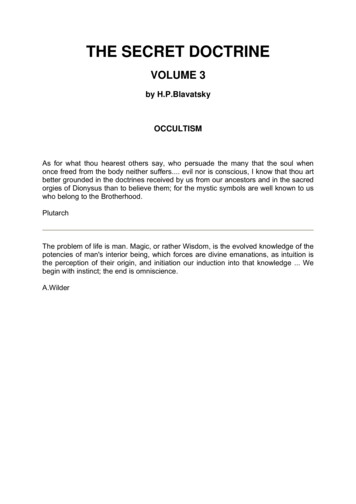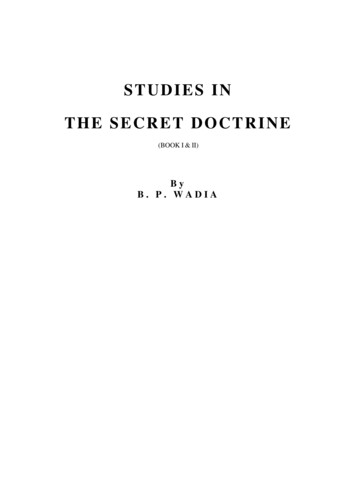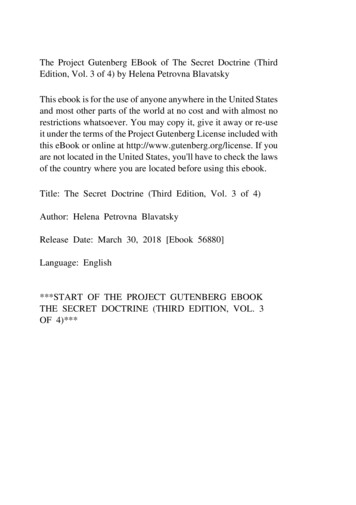
Transcription
The Project Gutenberg EBook of The Secret Doctrine (ThirdEdition, Vol. 3 of 4) by Helena Petrovna BlavatskyThis ebook is for the use of anyone anywhere in the United Statesand most other parts of the world at no cost and with almost norestrictions whatsoever. You may copy it, give it away or re-useit under the terms of the Project Gutenberg License included withthis eBook or online at http://www.gutenberg.org/license. If youare not located in the United States, you'll have to check the lawsof the country where you are located before using this ebook.Title: The Secret Doctrine (Third Edition, Vol. 3 of 4)Author: Helena Petrovna BlavatskyRelease Date: March 30, 2018 [Ebook 56880]Language: English***START OF THE PROJECT GUTENBERG EBOOKTHE SECRET DOCTRINE (THIRD EDITION, VOL. 3OF 4)***
The Secret DoctrineThe Synthesis of Science, Religion, andPhilosophyByHelena Petrovna BlavatskyAuthor of “Isis Unveiled.”Third and Revised Edition.SATYÂT NÂSTI PARO DHARMAH.“There is no Religion higher than Truth.”Volume III.The Theosophical Publishing HouseLondon1897
ContentsPreface. . . . . . . . . . . . . . . . . . . . . . . . . . . . 2Introductory. . . . . . . . . . . . . . . . . . . . . . . . . . 4Section I. Preliminary Survey. . . . . . . . . . . . . . . . 22Section II. Modern Criticism and the Ancients. . . . . . . 44Section III. The Origin of Magic. . . . . . . . . . . . . . . 52Section IV. The Secresy of Initiates. . . . . . . . . . . . . 62Section V. Some Reasons for Secresy. . . . . . . . . . . . 79Section VI. The Dangers of Practical Magic. . . . . . . . . 94Section VII. Old Wine in New Bottles. . . . . . . . . . . . 106Section VIII. The Book of Enoch the Origin and theFoundation of Christianity. . . . . . . . . . . . . . . . 114Section IX. Hermetic and Kabalistic Doctrines. . . . . . . 127Section X. Various Occult Systems of Interpretations ofAlphabets and Numerals. . . . . . . . . . . . . . . . . 136Section XI. The Hexagon with the Central Point, or theSeventh Key. . . . . . . . . . . . . . . . . . . . . . . 145Section XII. The Duty of the True Occultist toward Religions.150Section XIII. Post-Christian Adepts and their Doctrines. . . 153Section XIV. Simon and his Biographer Hippolytus. . . . . 160Section XV. St. Paul the real Founder of present Christianity.167Section XVI. Peter a Jewish Kabalist, not an Initiate. . . . 172Section XVII. Apollonius of Tyana. . . . . . . . . . . . . 176Section XVIII. Facts underlying Adept Biographies. . . . . 187Section XIX. St. Cyprian of Antioch. . . . . . . . . . . . . 219Section XX. The Eastern Gupta Vidya & the Kabalah. . . . 225Section XXI. Hebrew Allegories. . . . . . . . . . . . . . . 254Section XXII. The “Zohar” on Creation and the Elohim. . . 272Section XXIII. What the Occultists and Kabalists have tosay. . . . . . . . . . . . . . . . . . . . . . . . . . . . . 289
ivThe Secret Doctrine (Third Edition, Vol. 3 of 4)Section XXIV. Modern Kabalists in Science and OccultAstronomy. . . . . . . . . . . . . . . . . . . . . . . . 295Section XXV. Eastern and Western Occultism. . . . . . . 304Section XXVI. The Idols and the Teraphim. . . . . . . . . 319Section XXVII. Egyptian Magic. . . . . . . . . . . . . . . 328Section XXVIII. The Origin of the Mysteries. . . . . . . . 352Section XXIX. The Trial of the Sun Initiate. . . . . . . . . 367Section XXX. The Mystery “Sun of Initiation.” . . . . . . 376Section XXXI. The Objects of the Mysteries. . . . . . . . 382Section XXXII. Traces of the Mysteries. . . . . . . . . . . 390Section XXXIII. The Last of the Mysteries in Europe. . . . 405Section XXXIV. The Post-Christian Successors to theMysteries. . . . . . . . . . . . . . . . . . . . . . . . . 412Section XXXV. Symbolism of Sun and Stars. . . . . . . . 429Section XXXVI. Pagan Sidereal Worship, or Astrology. . . 442Section XXXVII. The Souls of the Stars—Universal Heliolatry. . . . . . . . . . . . . . . . . . . . . . . . . . . 451Section XXXVIII. Astrology and Astrolatry. . . . . . . . . 458Section XXXIX. Cycles and Avataras. . . . . . . . . . . . 468Section XL. Secret Cycles. . . . . . . . . . . . . . . . . . 474Section XLI. The Doctrine of Avataras. . . . . . . . . . . 488Section XLII. The Seven Principles. . . . . . . . . . . . . 506Section XLIII. The Mystery of Buddha. . . . . . . . . . . 509Section XLIV. “Reincarnations” of Buddha. . . . . . . . . 522Section XLV. An Unpublished Discourse of Buddha. . . . 531Section XLVI. Nirvana-Moksha. . . . . . . . . . . . . . . 534Section XLVII. The Secret Books of “Lam-Rin” and Dzyan.546Section XLVIII. Amita Buddha Kwan-Shai-yin, andKwan-yin.—What the “Book of Dzyan” and theLamaseries of Tsong-Kha-pa say. . . . . . . . . . . . . 550Section XLIX. Tsong-Kha-pa.—Lohans in China. . . . . . 553Section L. A few more Misconceptions Corrected. . . . . . 559Section LI. The “Doctrine of the Eye” & the “Doctrine ofthe Heart,” or the “Heart's Seal.” . . . . . . . . . . . . 572
vSome Papers On The Bearing Of Occult Philosophy On Life.585Paper I. A Warning. . . . . . . . . . . . . . . . . . . . 586Paper II. An Explanation. . . . . . . . . . . . . . . . . 616Paper III. A Word Concerning the Earlier Papers. . . . 659Appendix. Notes on Papers I., II. and III. . . . . . . . . 714Notes On Some Oral Teachings. . . . . . . . . . . . . 720Footnotes . . . . . . . . . . . . . . . . . . . . . . . . . . 791
[Transcriber's Note: The above cover image was produced bythe submitter at Distributed Proofreaders, and is being placedinto the public domain.][v]As for what thou hearest others say, who persuade the manythat the soul when once freed from the body neither suffers. evil nor is conscious, I know that thou art better groundedin the doctrines received by us from our ancestors and in thesacred orgies of Dionysus than to believe them; for the mysticsymbols are well known to us who belong to the Brotherhood.PLUTARCH.The problem of life is man. Magic, orrather Wisdom, is the evolved knowledge of the potencies ofman's interior being, which forces are divine emanations, asintuition is the perception of their origin, and initiation ourinduction into that knowledge. We begin with instinct; theend is omniscience.A. WILDER.[xix]
Preface.[xx]The task of preparing this volume for the press has been a difficult and anxious one, and it is necessary to state clearly whathas been done. The papers given to me by H. P. B. were quiteunarranged, and had no obvious order: I have, therefore, takeneach paper as a separate Section, and have arranged them assequentially as possible. With the exception of the correction ofgrammatical errors and the elimination of obviously un-Englishidioms, the papers are as H. P. B. left them, save as otherwisemarked. In a few cases I have filled in a gap, but any such addition is enclosed within square brackets, so as to be distinguishedfrom the text. In “The Mystery of Buddha” a further difficultyarose; some of the Sections had been written four or five timesover, each version containing some sentences that were not in theothers; I have pieced these versions together, taking the fullestas basis, and inserting therein everything added in any other versions. It is, however, with some hesitation that I have includedthese Sections in the Secret Doctrine. Together with some mostsuggestive thought, they contain very numerous errors of fact,and many statements based on exoteric writings, not on esotericknowledge. They were given into my hands to publish, as partof the Third Volume of the Secret Doctrine, and I therefore donot feel justified in coming between the author and the public,either by altering the statements, to make them consistent withfact, or by suppressing the Sections. She says she is actingentirely on her own authority, and it will be obvious to anyinstructed reader that she makes—possibly deliberately—manystatements so confused that they are mere blinds, and other statements—probably inadvertently—that are nothing more than theexoteric misunderstandings of esoteric truths. The reader must
Preface.3here, as everywhere, use his own judgment, but feeling bound topublish these Sections, I cannot let them go to the public withouta warning that much in them is certainly erroneous. Doubtless,had the author herself issued this book, she would have entirelyre-written the whole of this division; as it was, it seemed best togive all she had said in the different copies, and to leave it in itsrather unfinished state, for students will best like to have whatshe said as she said it, even though they may have to study itmore closely than would have been the case had she remained tofinish her work.The quotations made have been as far as possible found, andcorrect references given; in this most laborious work a wholeband of earnest and painstaking students, under the guidance ofMrs. Cooper-Oakley, have been my willing assistants. Withouttheir aid it would not have been possible to give the references,as often a whole book had to be searched through, in order tofind a paragraph of a few lines.This volume completes the papers left by H. P. B., with theexception of a few scattered articles that yet remain and thatwill be published in her own magazine Lucifer. Her pupils arewell aware that few will be found in the present generation to dojustice to the occult knowledge of H. P. B. and to her magnificentsweep of thought, but as she can wait to future generations forthe justification of her greatness as a teacher, so can her pupilsafford to wait for the justification of their trust.ANNIE BESANT.[001]
Introductory.“Power belongs to him who knows;” this is a very old axiom.Knowledge—the first step to which is the power of comprehending the truth, of discerning the real from the false—is forthose only who, having freed themselves from every prejudiceand conquered their human conceit and selfishness, are ready toaccept every and any truth, once it is demonstrated to them. Ofsuch there are very few. The majority judge of a work accordingto the respective prejudices of its critics, who are guided in theirturn by the popularity or unpopularity of the author, rather thanby its own faults or merits. Outside the Theosophical circle,therefore, the present volume is certain to receive at the handsof the general public a still colder welcome than its two predecessors have met with. In our day no statement can hope for afair trial, or even hearing, unless its arguments run on the lineof legitimate and accepted enquiry, remaining strictly within theboundaries of official Science or orthodox Theology.Our age is a paradoxical anomaly. It is preëminently materialistic and as preëminently pietistic. Our literature, our modernthought and progress, so called, both run on these two parallellines, so incongruously dissimilar and yet both so popular and sovery orthodox, each in its own way. He who presumes to draw athird line, as a hyphen of reconciliation between the two, has tobe fully prepared for the worst. He will have his work mangledby reviewers, mocked by the sycophants of Science and Church,misquoted by his opponents, and rejected even by the pious lending libraries. The absurd misconceptions, in so-called culturedcircles of society, of the ancient Wisdom-Religion (Bodhism) after the admirably clear and scientifically-presented explanationsin Esoteric Buddhism, are a good proof in point. They might have
Introductory.5served as a caution even to those Theosophists who, hardenedin an almost life-long struggle in the service of their Cause, areneither timid with their pen, nor in the least appalled by dogmaticassumption and scientific authority. Yet, do what Theosophicalwriters may, neither Materialism nor doctrinal pietism will evergive their Philosophy a fair hearing. Their doctrines will besystematically rejected, and their theories denied a place even inthe ranks of those scientific ephemera, the ever-shifting “workinghypotheses” of our day. To the advocate of the “animalistic”theory, our cosmogenetical and anthropogenetical teachings are“fairy-tales” at best. For to those who would shirk any moralresponsibility, it seems certainly more convenient to accept descent from a common simian ancestor and see a brother in adumb, tailless baboon, than to acknowledge the fatherhood ofPitris, the “Sons of God,” and to have to recognise as a brother astarveling from the slums.“Hold back!” shout in their turn the pietists. “You will never make of respectable church-going Christians Esoteric Buddhists!”Nor are we, in truth, in any way anxious to attempt the metamorphosis. But this cannot, nor shall it, prevent Theosophistsfrom saying what they have to say, especially to those who, in opposing to our doctrine Modern Science, do so not for her own fairsake, but only to ensure the success of their private hobbies andpersonal glorification. If we cannot prove many of our points, nomore can they; yet we may show how, instead of giving historicaland scientific facts—for the edification of those who, knowingless than they, look to Scientists to do their thinking and formtheir opinions—the efforts of most of our scholars seem solelydirected to killing ancient facts, or distorting them into props tosupport their own special views. This will be done in no spirit ofmalice or even criticism, as the writer readily admits that most ofthose she finds fault with stand immeasurably higher in learningthan herself. But great scholarship does not preclude bias and[002]
6[003]The Secret Doctrine (Third Edition, Vol. 3 of 4)prejudice, nor is it a safeguard against self-conceit, but rather thereverse. Moreover, it is but in the legitimate defence of our ownstatements, i.e., the vindication of Ancient Wisdom and its greattruths, that we mean to take our “great authorities” to task.Indeed, unless the precaution of answering beforehand certainobjections to the fundamental propositions in the present workbe adopted—objections which are certain to be made on theauthority of this, that, or another scholar concerning the Esotericcharacter of all the archaic and ancient works on Philosophy—ourstatements will be once more contradicted and even discredited.One of the main points in this Volume is to indicate in theworks of the old Âryan, Greek, and other Philosophers of note,as well as in all the world-scriptures, the presence of a strongEsoteric allegory and symbolism. Another of the objects is toprove that the key of interpretation, as furnished by the Eastern Hindu-Buddhistic canon of Occultism—fitting as well theChristian Gospels as it does archaic Egyptian, Greek, Chaldæan,Persian, and even Hebrew-Mosaic Books—must have been onecommon to all the nations, however divergent may have beentheir respective methods and exoteric “blinds.” These claimsare vehemently denied by some of the foremost scholars of ourday. In his Edinburgh Lectures, Prof. Max Müller discardedthis fundamental statement of the Theosophists by pointing tothe Hindu Shâstras and Pandits, who know nothing of suchEsotericism.1 The learned Sanskrit scholar stated in so manywords that there was no hidden meaning, no Esoteric element or“blinds,” either in the Purânas or the Upanishads. Consideringthat the word “Upanishad” means, when translated, the “Secret1The majority of the Pandits know nothing of the Esoteric Philosophy now,because they have lost the key to it; yet not one of these, if honest, woulddeny that the Upanishads, and especially the Purânas, are allegorical andsymbolical; nor that there still remain in India a few great scholars who could,if they would, give them the key to such interpretations. Nor do they reject theactual existence of Mahâtmâs—initiated Yogis and Adepts—even in this ageof Kali Yuga.
Introductory.7Doctrine,” the assertion is, to say the least, extraordinary. SirM. Monier Williams again holds the same view with regard toBuddhism. To hear him is to regard Gautama, the Buddha, as anenemy of every pretence to Esoteric teachings. He himself nevertaught them! All such “pretences” to Occult learning and “magicpowers” are due to the later Arhats, the subsequent followers ofthe “Light of Asia”! Prof. B. Jowett, again, as contemptuouslypasses the sponge over the “absurd” interpretations of Plato'sTimæus and the Mosaic Books by the Neoplatonists. There isnot a breath of the Oriental (Gnostic) spirit of Mysticism inPlato's Dialogues, the Regius Professor of Greek tells us, norany approach to Science, either. Finally, to cap the climax, Prof.Sayce, the Assyriologist, although he does not deny the actualpresence, in the Assyrian tablets and cuneiform literature, of ahidden meaning—Many of the sacred texts . so written as to be intelligibleonly to the initiated—yet insists that the “keys and glosses” thereof are now in thehands of the Assyriologists. The modern scholars, he affirms,have in their possession clues to the interpretation of the EsotericRecords,Which even the initiated priests [of Chaldæa] did not possess.[004]Thus, in the scholarly appreciation of our modern Orientalistsand Professors, Science was in its infancy in the days of theEgyptian and Chaldæan Astronomers. Pânini, the greatest Grammarian in the world, was unacquainted with the art of writing. Sowas the Lord Buddha, and everyone else in India until 300 B.C.The grossest ignorance reigned in the days of the Indian Rishis,and even in those of Thales, Pythagoras, and Plato. Theosophistsmust indeed be superstitious ignoramuses to speak as they do, inthe face of such learned evidence to the contrary!
8[005]The Secret Doctrine (Third Edition, Vol. 3 of 4)Truly it looks as if, since the world's creation, there has beenbut one age of real knowledge on earth—the present age. In themisty twilight, in the grey dawn of history, stand the pale shadowsof the old Sages of world renown. They were hopelessly gropingfor the correct meaning of their own Mysteries, the spirit whereofhas departed without revealing itself to the Hierophants, and hasremained latent in space until the advent of the initiates of Modern Science and Research. The noontide brightness of knowledgehas only now arrived at the “Know-All,” who, basking in thedazzling sun of induction, busies himself with his Penelopeiantask of “working hypotheses,” and loudly asserts his rights touniversal knowledge. Can anyone wonder, then, that accordingto present views the learning of the ancient Philosopher, andeven sometimes that of his direct successors in the past centuries,has ever been useless to the world and valueless to himself? For,as explained repeatedly in so many words, while the Rishis andthe Sages of old have walked far over the arid fields of myth andsuperstition, the mediæval Scholar, and even the average eighteenth century Scientist, have always been more or less crampedby their “supernatural” religion and beliefs. True, it is generallyconceded that some ancient and also mediæval Scholars, such asPythagoras, Plato, Paracelsus, and Roger Bacon, followed by ahost of glorious names, had indeed left not a few landmarks overprecious mines of Philosophy and unexplored lodes of PhysicalScience. But then the actual excavation of these, the smeltingof the gold and silver, and the cutting of the precious jewelsthey contain, are all due to the patient labours of the modernman of Science. And is it not to the unparalleled genius ofthe latter that the ignorant and hitherto-deluded world owes acorrect knowledge of the real nature of the Kosmos, of the trueorigin of the universe and man, as revealed in the automatic andmechanical theories of the Physicists, in accordance with strictlyscientific Philosophy? Before our cultured era, Science was buta name, Philosophy a delusion and a snare. According to the
Introductory.9modest claims of contemporary authority on genuine Science andPhilosophy, the Tree of Knowledge has only now sprung fromthe dead weeds of superstition, as a beautiful butterfly emergesfrom an ugly grub. We have, therefore, nothing for which tothank our forefathers. The Ancients have at best prepared andfertilised the soil; it is the Moderns who have planted the seedsof knowledge and reared the lovely plants called blank negationand sterile agnosticism.Such, however, is not the view taken by Theosophists. Theyrepeat what was stated twenty years ago. It is not sufficientto speak of the “untenable conceptions of an uncultured past”(Tyndall); of the “parler enfantin” of the Vaidic poets (MaxMüller); of the “absurdities” of the Neoplatonists (Jowett); andof the ignorance of the Chaldæo-Assyrian initiated Priests withregard to their own symbols, when compared with the knowledgethereon of the British Orientalist (Sayce). Such assumptions haveto be proven by something more solid than the mere word ofthese scholars. For no amount of boastful arrogance can hidethe intellectual quarries out of which the representations of somany modern Philosophers and Scholars have been carved. Howmany of the most distinguished European Scientists have derived honour and credit for the mere dressing-up of the ideas ofthese old Philosophers, whom they are ever ready to disparage,is left to an impartial posterity to say. Thus it does seem notaltogether untrue as stated in Isis Unveiled, to say of certainOrientalists and Scholars of dead languages, that they will allowtheir boundless conceit and self-opinionatedness to run awaywith their logic and reasoning powers, rather than concede to theancient Philosophers the knowledge of anything the modern donot know.As part of this work treats of the Initiates and the secretknowledge imparted during the Mysteries, the statements ofthose who, in spite of the fact that Plato was an Initiate, maintainthat no hidden Mysticism is to be discovered in his works, have
10[006]The Secret Doctrine (Third Edition, Vol. 3 of 4)to be first examined. Too many of the present scholars, Greekand Sanskrit, are but too apt to forego facts in favour of theirown preconceived theories based on personal prejudice. Theyconveniently forget, at every opportunity, not only the numerous changes in language, but also that the allegorical style inthe writings of old Philosophers and the secretiveness of theMystics had their raison d'être; that both the pre-Christian andthe post-Christian classical writers—the great majority at allevents—were under the sacred obligation never to divulge thesolemn secrets communicated to them in the sanctuaries; andthat this alone is sufficient to sadly mislead their translators andprofane critics. But these critics will admit nothing of the kind,as will presently be seen.For over twenty-two centuries everyone who has read Platohas been aware that, like most of the other Greek Philosophersof note, he had been initiated; that therefore, being tied downby the Sodalian Oath, he could speak of certain things only inveiled allegories. His reverence for the Mysteries is unbounded;he openly confesses that he writes “enigmatically,” and we seehim take the greatest precautions to conceal the true meaningof his words. Every time the subject touches the greater secretsof Oriental Wisdom—the cosmogony of the universe, or theideal preëxisting world—Plato shrouds his Philosophy in theprofoundest darkness. His Timæus is so confused that no one butan Initiate can understand the hidden meaning. As already saidin Isis Unveiled:The speculations of Plato in the Banquet on the creation, orrather the evolution, of primordial men, and the essay oncosmogony in the Timæus, must be taken allegorically if weaccept them at all. It is this hidden Pythagorean meaning inTimæus, Cratylus, and Parmenides, and a few other trilogiesand dialogues, that the Neoplatonists ventured to expound, asfar as the theurgical vow of secresy would allow them. ThePythagorean doctrine that God is the Universal Mind diffused
Introductory.11through all things, and the dogma of the soul's immortality, are the leading features in these apparently incongruousteachings. His piety and the great veneration he felt for theMysteries are sufficient warrant that Plato would not allowhis indiscretion to get the better of that deep sense of responsibility which is felt by every Adept. “Constantly perfectinghimself in perfect Mysteries a man in them alone becomestruly perfect,” says he in the Phædrus.He took no pains to conceal his displeasure that the Mysteries had become less secret than formerly. Instead of profaningthem by putting them within the reach of the multitude, hewould have guarded them with jealous care against all but themost earnest and worthy of his disciples.2 While mentioningthe Gods on every page, his monotheism is unquestionable,for the whole thread of his discourse indicates that by the term“Gods” he means a class of beings lower in the scale thanDeities, and but one grade higher than men. Even Josephusperceived and acknowledged this fact, despite the naturalprejudice of his race. In his famous onslaught upon Apion,this historian says: “Those, however, among the Greeks whophilosophized in accordance with truth were not ignorant ofanything, . nor did they fail to perceive the chilling superficialities of the mythical allegories, on which account theyjustly despised them. By which thing Plato, being moved,says it is not necessary to admit any one of the other poets into‘the Commonwealth,’ and he dismisses Homer blandly, afterhaving crowned him and pouring unguent upon him, in orderthat indeed he should not destroy by his myths, the orthodoxbelief respecting one God.”32This assertion is clearly corroborated by Plato himself, who writes: “Yousay that in my former discourse I have not sufficiently explained to you thenature of the First. I purposely spoke enigmatically, that in case the tabletshould have happened with any accident, either by sea or land, a person withoutsome previous knowledge of the subject might not be able to understand itscontents.” (Plato, Ep., ii. 312; Cory, Ancient Fragments, p. 304.)3Isis Unveiled, i. 287, 288.[007]
12[008]The Secret Doctrine (Third Edition, Vol. 3 of 4)And this is the “God” of every Philosopher, God infinite andimpersonal. All this and much more, which there is no roomhere to quote, leads one to the undeniable certitude that (a), asall the Sciences and Philosophies were in the hands of the templeHierophants, Plato, as initiated by them, must have known them;and (b), that logical inference alone is amply sufficient to justify anyone in regarding Plato's writings as allegories and “darksayings,” veiling truths which he had no right to divulge.This established, how comes it that one of the best Greek scholars in England, Prof. Jowett, the modern translator of Plato'sworks, seeks to demonstrate that none of the Dialogues—including even the Timæus—have any element of Oriental Mysticismabout them? Those who can discern the true spirit of Plato'sPhilosophy will hardly be convinced by the arguments which theMaster of Balliol College lays before his readers. “Obscure andrepulsive” to him, the Timæus may certainly be; but it is as certainthat this obscurity does not arise, as the Professor tells his public,“in the infancy of physical science,” but rather in its days ofsecresy; not “out of the confusion of theological, mathematical,and physiological notions,” or “out of the desire to conceive thewhole of Nature without any adequate knowledge of the parts.”4For Mathematics and Geometry were the backbone of Occultcosmogony, hence of “Theology,” and the physiological notionsof the ancient Sages are being daily verified by Science in ourage; at least, to those who know how to read and understandancient Esoteric works. The “knowledge of the parts” availsus little, if this knowledge only leads us the more to ignoranceof the Whole, or the “nature and reason of the Universal,” asPlato called Deity, and causes us to blunder most egregiouslybecause of our boasted inductive methods. Plato may have been“incapable of induction, or generalization in the modern sense”;54The Dialogues of Plato, translated by B. Jowett, Regius Professor of Greekat the University of Oxford, iii. 523.5Op. cit., p. 561.
Introductory.13he may have been ignorant also, of the circulation of the blood,which, we are told, “was absolutely unknown to him,”6 but then,there is naught to disprove that he knew what blood is—and thisis more than any modern Physiologist or Biologist can claimnowadays.Though a wider and far more generous margin for knowledgeis allowed the “physical philosopher” by Prof. Jowett than bynearly any other modern commentator and critic, nevertheless,his criticism so considerably outweighs his laudation, that it maybe as well to quote his own words, to show clearly his bias. Thushe says:To bring sense under the control of reason; to find someway through the labyrinth or chaos of appearances, either thehighway of mathematics, or more devious paths suggestedby the analogy of man with the world and of the world withman; to see that all things have a cause and are tendingtowards an end—this is the spirit of the ancient physicalphilosopher.7 But we neither appreciate the conditions ofknowledge to which he was subjected, nor have the ideaswhich fastened upon his imagination the same hold upon us.For he is hovering between matter and mind; he is under thedominion of abstractions; his impressions are taken almostat random from the outside of nature; he sees the light, butnot the objects which are revealed by the light; and he bringsinto juxtaposition things which to us appear wide as the polesasunder, because he finds nothing between them.6Op. cit., p. 591.This definition places (unwittingly, of course), the ancient “physical philosopher” many cubits higher than his modern “physical” confrère, since the ultimathule of the latter is to lead mankind to believe that neither universe nor manhave any cause at all—not an intelligent one at all events—and that they havesprung into existence owing to blind chance and a senseless whirling of atoms.Which of the two hypotheses is the more rational
Mar 30, 2018 · 6 The Secret Doctrine (Third Edition, Vol. 3 of 4) prejudice, nor is it a safeguard against self-conceit, but rather the reverse. Moreover, it is but in the legitimate defence of our own statements, i.e., the vindication of Ancient Wisdom and its great tru
